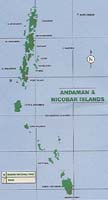| Destinations
|
|||||||||
Ancient and Medieval Contrary to the above descriptions, accounts of the ferocity of the Andamanese seem to be propagated by Malay pirates who held sway over the surrounding seas and needed to keep looters well away from trade ships that passed between India, China and the Far East. The Nicobar Islands are located 50 km south of Little Andaman. 13 of the 19 Nicobar Islands are inhabited by about 12,000 aboriginal tribesmen most of whom live on Car Nicobar, the northern most of the archipelago. Port Blair, the capital of the Andaman and Nicobar Islands is 780 miles from Calcutta, 749 miles from Chennai and120 miles from Cape Negrais in Myanmar. |
More on Andamans • Overview • Geography • People • Economy • Climate • Port Blair
Travelogues
Adventure
|
||||||||
In the seventeenth century the islands witnessed Maratha Rule.
Several futile attempts to convert the Nicobarese to
Christianity were made by the French, Dutch and Danish, in the
17th and 18th centuries, when plans were abandoned in the face
of repugnant diseases and a severe lack of food and water.
Trading companies met with a more treacherous fate at the
hands of the Nicobarese with their ships captured and their
crew murdered.
Modern Compiled by Puneet Sachdeva
|
|||||||||
Editor: Romola Butalia (c) India Travelogue. All rights reserved. |
|||||||||
 The Roman geographer Ptolemy first referred to the Andaman and
Nicobar Islands as the island of cannibals, in the second
century AD. Chinese Buddhist monk, Xuan Zang in the seventh
century and Arabian travellers in the ninth, spoke of the
inhabitants as fierce and cannibalistic. Marco Polo's
description of the islanders in the 13th century was similar.
The Roman geographer Ptolemy first referred to the Andaman and
Nicobar Islands as the island of cannibals, in the second
century AD. Chinese Buddhist monk, Xuan Zang in the seventh
century and Arabian travellers in the ninth, spoke of the
inhabitants as fierce and cannibalistic. Marco Polo's
description of the islanders in the 13th century was similar.
 Port Blair became a penal colony at the end of the nineteenth
century. The Cellular Jail built over a period of 18 years
from 1890 to 1908 housed thieves and smugglers but later, on
the lines of Sumatra, Singapore and Penang, freedom fighters
and political activists were sentenced to two decades of
imprisonment on these islands, which came to be known as Kala
Pani or Black Water. Made up of hundreds of tiny solitary
cells it was used to confine political prisoners until 1945.
During World War II the islands were occupied by the Japanese,
who tortured and murdered hundreds, suspected of collaborating
with the British. British forces moved back in 1945 and
abolished the penal settlement.
Port Blair became a penal colony at the end of the nineteenth
century. The Cellular Jail built over a period of 18 years
from 1890 to 1908 housed thieves and smugglers but later, on
the lines of Sumatra, Singapore and Penang, freedom fighters
and political activists were sentenced to two decades of
imprisonment on these islands, which came to be known as Kala
Pani or Black Water. Made up of hundreds of tiny solitary
cells it was used to confine political prisoners until 1945.
During World War II the islands were occupied by the Japanese,
who tortured and murdered hundreds, suspected of collaborating
with the British. British forces moved back in 1945 and
abolished the penal settlement.